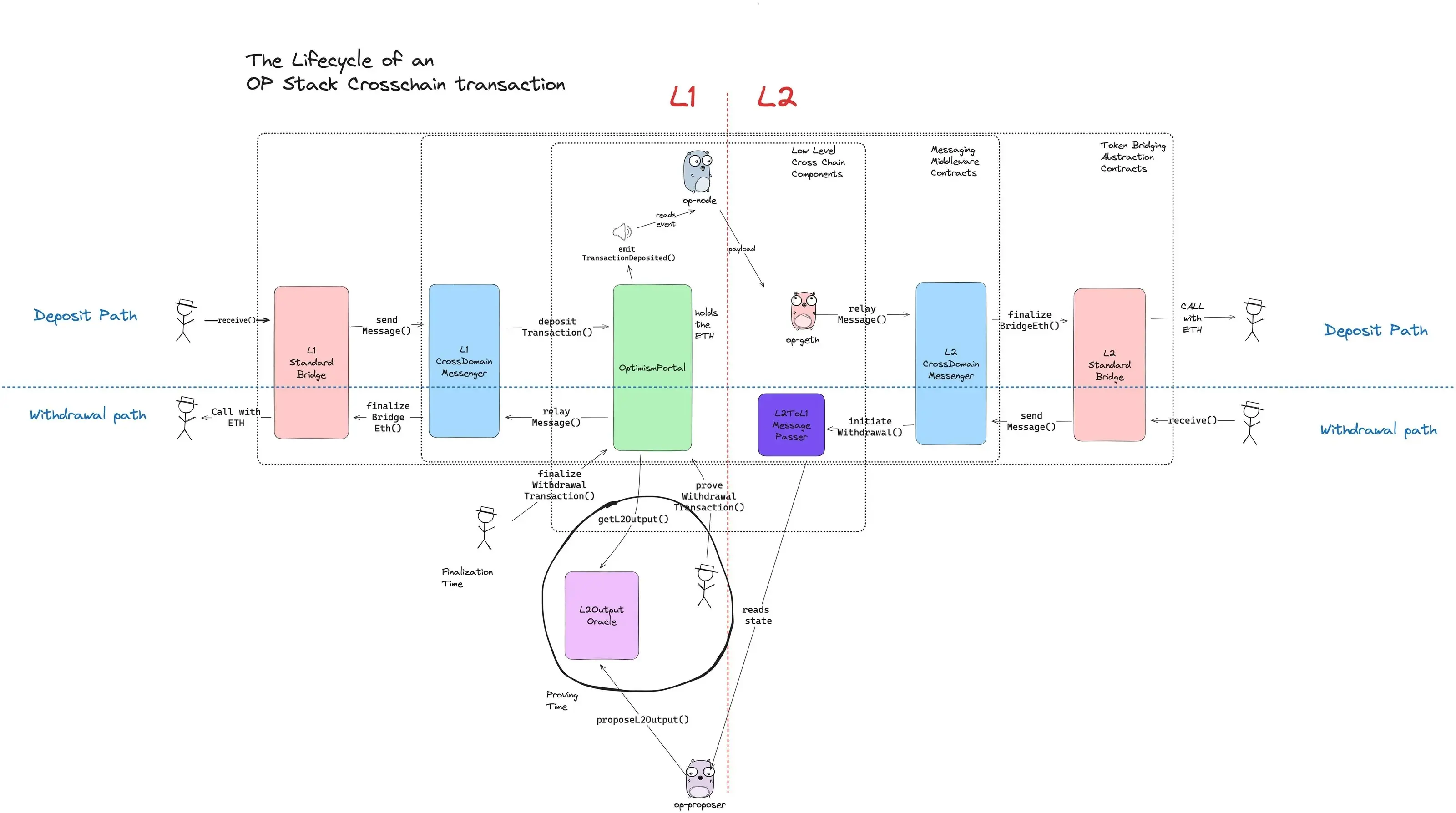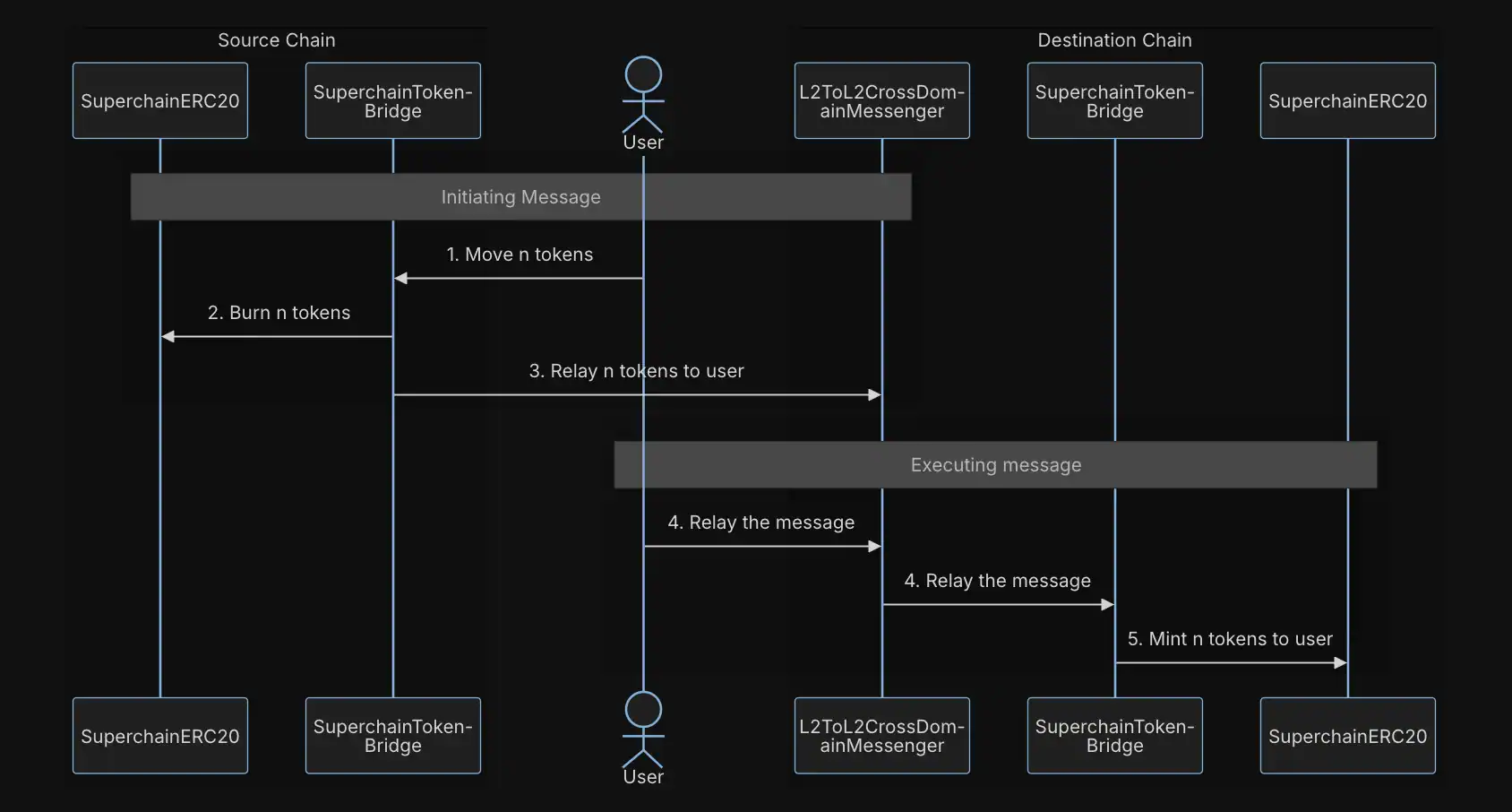OPStack's Bridge Component Explainer
A technical article guiding how OPStack's Bridge Contracts works
Posted by
Related reading
OPStack's Proxy Component Explainer
A technical article guiding how OPStack's Proxy Contracts works
A dev framework to modify & deploy OPStack ’s contracts.
An interactive OPStack 's smart contract generator
OPStack’s Bridge Component Explainer
This article highlights and aim as a guide how bridges implemented in OP Stack monorepo codebase works. The content is very recommended for smart contract developers/auditors who want to understand the core logics of OP Stack.
Note💡 This bridge represents part of core logics in L2 implementations components.
In simple words, OP Stack is a common development stack for building L2 blockchain ecosystems, and L2 are just blockchains with safe bridging. Also, bridge contracts allows cross domain transfers of data ETH and ERC20 token across ethereum L1 and L2s.
There are 2 types of bridge systems:
1. From L1 to L2 transactions and Vice versa
Message Transfer
In general, when passing messages between L1 and L2, CrossDomainMessenger contract’s functionalites are extended into L1CrossDomainMessenger and L2CrossDomainMessenger for L1 and L2 respectively.
Both contracts are resposible for relaying messages between the L1 and L2 layers. Then the next exexutions will be done on the destination chain.
For L1 to L2 path, messages sent are automatically relayed behind the scenes.
For L2 to L1 path, L2ToL1MessagePasser contract is required to queue those messages when preparing for state updates . Then, a second transaction on L1 is required to relayed in order to complete the tx.
Asset Transfer
Considering more complex use cases, StandardBridge contract is an abstraction built on top of the CrossDomainMessenger, and it could be used to implement the bridge. The official implementations inlude L1StandardBridge, L2StandardBridge, L1ERC721Bridge and L2ERC721Bridge. They are abstracted to bridge ETH and ERC20 tokens between L1 and L2. Otherwise, new customized bridge contracts can be built to support more advanced features.
Tip💡 Check how to build customized bridge on this tutorial.
This below diagram shows the workflow of StandardBridge system:

This StandardBridge system mandates the token deployed on L2 to be customized and conformed to OptimismMintableERC20 standard. This extends the standard ERC-20 specification, incorporating additional functions that enable the bridge to validate deposits and withdrawals while managing token minting and burning. Check this official tutorial for more details.
Tip💡 The
OptimismMintableERC20Factorycontract can be used to generate ERC-20 contracts on L2, enabling the deposit of native L1 tokens intoOptimismMintableERC20contracts. This is the same forOptimismMintableERC721andOptimismMintableERC721Factoryfor ERC-721 tokens.
Note💡 These are link to relevant contract source code:
CrossDomainMessengerL1CrossDomainMessengerL2CrossDomainMessengerpredeployed at0x4200000000000000000000000000000000000016L1StandardBridgeL2StandardBridgepredeployed at0x4200000000000000000000000000000000000010L1ERC721BridgeL2ERC721Bridgepredeployed at0x4200000000000000000000000000000000000014OptimismMintableERC20OptimismMintableERC20Factorypredeployed at0x4200000000000000000000000000000000000012OptimismMintableERC721OptimismMintableERC721Factorypredeployed at0x4200000000000000000000000000000000000017L2ToL1MessagePasser1deployed at0x4200000000000000000000000000000000000007
2. Between L2 and L2 transactions
As above, it can be seen that bridging means fragmented ecosystem and poor user experience where users struggle to interact with applications across various L2 OPStack chains, as they have to bridge every time they want to transfer across different L2s.
OP Stack’s interoperability aims to solve this problem by providing a seamless way to transfer assets between different L2s without requiring users to interact with multiple L2s.
Message Transfer
CrossL2Inbox allows anyone to initiate the execution or verification of cross-chain messages on behalf of any user.
The L2ToL2CrossDomainMessenger is a higher-level abstraction built on top of the CrossL2Inbox, facilitating general message passing. It primarily included but not limited to securely transferring ERC-20 tokens between L2 chains. It also ensures replay protection, domain binding, and provides access to additional message details. xs

When relaying a message via the L2ToL2CrossDomainMessenger, it a reqiuirement that the _destination matches block.chainid to ensure the message is valid only on a specific chain. The message hash is utilized for replay protection.
Additionally, the source chain must be included in the dependency set of the destination chain; otherwise, the message may become not playable.
To relay a message, the identifier of a event must be provided along with its associated message payload.
Note💡
The Identifier that uniquely represents a log that is emitted from a chain.
struct Identifier { address origin; uint256 blocknumber; uint256 logIndex; uint256 timestamp; uint256 chainid; }
Asset Transfer
To achieve asset interoperability , ERC7802 (by Defiwonderland, UniswapLab and OP lab) are proposed as a standard for interoperability, and one of its implemenation is SuperchainERC20 standard by OP Lab to enable asset interoperability across the Superchain.
Simply speaking, it works by burning tokens on the source chain and minting an equivalent amount on the destination chain.
In particular, SuperchainERC20 standard is an interface allowing ERC20 to be fungible across the Superchain using the official SuperchainTokenBridge, predeployed contract that serves as an abstraction layer over the L2ToL2CrossDomainMessenger for token bridging. It has mint and burn rights over SuperchainERC20 tokens.
Tip💡 Check and try superfuse.ninja to create your own
SuperchainERC20token.
This below diagram shows the workflow of SuperchainERC20 standard:

This SuperchainERC20 system requires dApp developer to complete two steps.
Authorize the
SuperchainTokenBridge(predeployed at0x4200000000000000000000000000000000000028) to executecrosschainMintandcrosschainBurn. IfSuperchainERC20is used, this permission is already granted.Deploy the ERC-20 contract at the same address across all chains within the Superchain network, and this can be achieved by using
CREATE2opcode.
Tip💡 The
OptimismSuperchainERC20Factorycontract can be used to creareSuperchainERC20contracts on L2. These contracts, known asOptimismSuperchainERC20, grant mint-burn permissions to theL2StandardBridge, include aremoteTokenvariable, and can be converted to and fromOptimismMintableERC20tokens. The purpose ofOptimismSuperchainERC20is to enhanceOptimismMintableERC20with interoperability.
Note💡 These are link to relevant contract source code:
CrossL2Inboxpredeployed at0x4200000000000000000000000000000000000022L2ToL2CrossDomainMessengerpredeployed at0x4200000000000000000000000000000000000023SuperchainERC20SuperchainTokenBridgepredeployed at0x4200000000000000000000000000000000000028OptimismSuperchainERC20Factorypredeployed at0x4200000000000000000000000000000000000029OptimismSuperchainERC20
Conclusion
In this article, we have discussed the bridge components in the OP Stack monorepo codebase. We have covered the core predeployed components of CrossDomainMessenger for L1 to L2 bridging and vice versa, as well as the CrossL2Inbox and SuperchainERC20 for L2 to L2 bridging.
Now, it is known that OP Stack’s bridge system can be deployed or more advanced smart contracts could be built on top of it, so new smore advanced features regarding interoperability can be unlocked.
Warning💡 This article is only for educational purposes and we note that the codebase is still experimental. Use it at your own risk.




